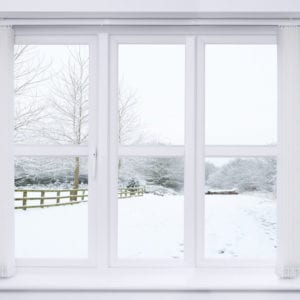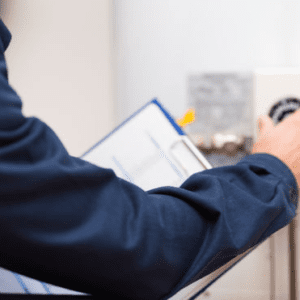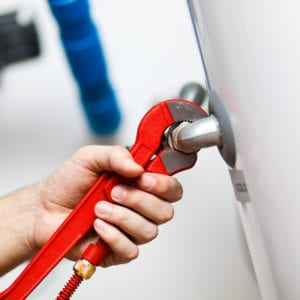5 Things To Do Before Turning On The Furnace This Winter
Natural gas furnaces are commonplace here in the Greater Toronto Area. With proper care and maintenance, these heating systems are clean, efficient, and perfectly safe. Regardless, there are steps you should take now to ensure your family is safe and warm when the temperature falls.
Here are 5 things we recommend you do before turning on the furnace this winter.
Furnace Safety Checklist
Planning to fire up the furnace soon? Be sure to take these steps before you do:
- Replace or clean the furnace filter.
- Clean and tidy the area around the furnace.
- Open the registers and move any obstructions.
- Test your carbon monoxide detector.
- Set the thermostat.
We’ll expand on each of these points below.
We also recommend having your gas furnace serviced annually. Along with ensuring safety and efficiency, preventative furnace maintenance is key to preventing costly furnace repairs.
1. Replace or Clean the Furnace Filter
When the furnace draws air from your home, it also pulls in the tiny particles that populate the air: specks of dust, pet dander, pollen, and other airborne allergens. That’s why gas furnaces are equipped with a mechanical air filter. The filter traps particles and takes them out of circulation.
It doesn’t take long for the filter to fill up with dirt and debris; one look at this photo of a furnace filter after three months will tell you. If the filter is not replaced after three months (or cleaned, in the case of an aluminium or plastic mesh) it begins to cut the air flow and reduce the furnace’s efficiency.
Start fresh with a clean filter before turning on the furnace this winter.
2. Clean and Tidy the Area Around the Furnace
It happens that furnaces tend to be installed in parts of our homes that are prone to accumulate clutter.
It’s not unusual for our technicians to find the furnace crowded by boxes, suitcases and laundry bins while on a call for furnace repair in Toronto and the GTA. All that clutter makes it harder to perform necessary maintenance.
In many cases, clutter is also a safety issue. Objects hanging near the furnace or leaning against it can reduce airflow. Cleaning products stored nearby can emit fumes that get drawn in and circulated throughout the home. Combustibles like paint or varnish are a serious fire hazard.
Before you turn on the furnace, make sure it has enough breathing room. Check the manual or ask your service technician how much clearance the system requires.
3. Open the Registers and Remove Obstructions
Take a walk through each room in your house to ensure the vents are open and nothing is blocking the flow of air. Common culprits for airflow obstructions include curtains, furniture, rugs, and clothing (especially if your kids are prone to miss the laundry hamper).
Simple as it is, this step is important in ensuring your system can distribute heat evenly and operate efficiently.
4. Test Your Carbon Monoxide Detector
Carbon monoxide (CO) is a colourless, odourless by-product of gas-fired appliances like furnaces and water heaters. A properly-installed and well-maintained furnace produces minimal CO and vents it safely outside the home.
Although the risk is small, it’s vital to ensure your carbon monoxide detectors are ready to warn you in the event of a leak. Some fire officials also recommend using a backup plug-in unit in addition to the ones permanently installed in your home.
If you’re not sure how to test your carbon monoxide alarms, or are unsure where to find them, contact your local Fire Department.
5. Set the Thermostat
Heating accounts for a whopping 62% of the average Canadian’s energy costs. One of the simplest and most powerful ways to reduce that cost is to turn down the heat when you don’t need it.
Most homes now have a programmable thermostat that can adjust the temperature automatically at set intervals; many now have a smart Wi-Fi thermostat that enables even greater control. In either case, lowering the temperature a few degrees for just a few hours a day can cut your energy use by 8% or more.
Worried about frozen water pipes? Keep the indoor temperature above 13°C.
Have You Had Your Furnace Serviced?
Some furnace problems are harder to spot than others. A bit of preventative maintenance can go a long way in preventing those minor issues from becoming a major headache down the road. That’s why we recommend having your furnace serviced annually.
Furnace breakdowns are not only inconvenient; if you don’t have an annual service plan, they can be expensive as well. Major repairs are the last thing you need on mind in the busy holiday season.
A neglected furnace can also put your family at considerable risk. Poorly-maintained piping and wear-and-tear increases the risk of fire and carbon monoxide leaks.
AtlasCare is always there for furnace service and maintenance throughout the Greater Toronto Area. Call us or leave us a message to inquire about having your furnace serviced today. We’ll get in touch as soon as we can.






